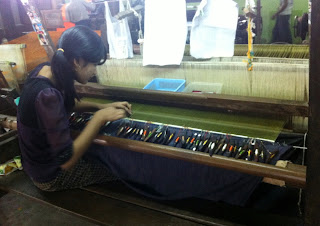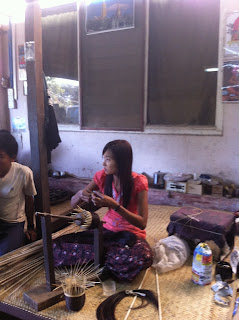Part VI - Different colours, different creeds, different people have different needs
“At its
foot [of the fort in Mandalay] is a broad sward planted quite thickly with
tamarind, cassia and acacia; and here in the evening you see the Burmese in
their coloured skirts and bright handkerchiefs wander in twos and threes. They
are little brown men of a solid and sturdy build, with something a trifle
Mongolian in their faces. They walk deliberately as if they are the owners and
tillers of the soil. They have none of the sidelong grace, the deprecating
elegance, of the Indian who passes them; they have not his refinement of features, nor his languorous, effeminate
distinction. They smile easily. They are happy, cheerful and amiable.” – WSM,
The Gentleman in the Parlour
They are.
As a whole, the Burmese look remarkably happy, content and at peace. They are the
most cheerful, hospitable and amiable people I have ever met. Is it the sun
that beats down from the clear blue sky, the colours of the earth, the flowers
in the grass or the permeating effect of centuries and centuries of Buddhism, I
cannot tell, but look at their radiant smiles and you start smiling yourself, perhaps
for no other reason than the social device called mirroring which scientist
have identified as a way of bonding to create rapport and avoid aggression. Whatever.
It works.
There is
something paradisiacal about their life stance and one is all too easily
tempted, if one is an incurable romantic like I am, to idealise the handicraft
version of ‘simple living’ and laud the pastoral delights of the farmer’s life.
I have always had a soft spot for it, to be compared with the alluring charms
slow cooking held for me while leaning back in my comfy armchair. Freely
translated it means it is all very well until you have to do it yourself and
your day runs out of hours and your wallet out of money.
Our Shan
guide Té, who likes gaming on his Samsung Galaxy 2 tablet, also seemed to
harbour some nationalistic say ‘enthusiasm’ for the Shan cause and some pressing
social issues. He told us a few facts. It’s all very well for the cheroot girl
to roll and cut cigarettes in what looks like the picturesque Inle Lake
Té also has
a theory why so many ancient pagodas are crumbling ruins: the Shan people have
no time to spend on the conservation of monuments because most of them are
farmers and they work very, very hard. This seems to be corroborated by the
words Maugham puts in the mouth of an Italian priest: “They work. Men and women
work together. It is a constant round of unceasing toil. Believe me, life is
not easy in the jungle villages up in the mountains. They sow their rice, and
you know what time and trouble it takes, and then they reap it; they cultivate
opium, and when they have an interval they go into the jungle to gather the
jungle produce. They do not starve, but they only save themselves from starvation
because they never rest.”
In a
country where no-one has a refrigerator, fresh produce has to be bought daily.
Hence the vibrant, hectic, colourful markets in nearly every village. Buy
local, spin your lotus threads, weave your clothes, lacquer your cups and
plates (a necessity to prevent rot), bake your sesame rice crackers, build your own
stilt house.
Pas cher,
as some women said trying to sell home-spun handkerchiefs to embarking French
tourists.
Definition
Simple living encompasses a number of different voluntary practices to simplify one’s
lifestyle. These may include reducing one's possessions or increasing self-sufficiency, for example. Simple
living may be characterized by individuals being satisfied with what they need rather
than want. Although asceticisism generally promotes living
simply and refraining from luxury and indulgence, not all proponents of simple
living are ascetics. Simple living is distinct from those living in
forced poverty, as it is a voluntary lifestyle choice.
By clicking
the pictures below, they open up in a gallery.






































































































No comments:
Post a Comment